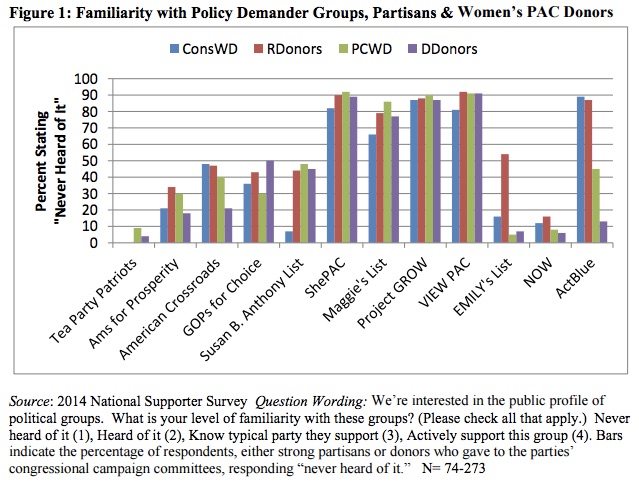EMILY’s List Lends its Fundraising Might to Help Hillary Clinton; Conservative Women’s PACs a Non-factor with Republican Presidential Candidates
 In April 2015, the Barbara Lee Family Foundation (BLFF) and the Center for American Women and Politics (CAWP) launched Presidential Gender Watch 2016, a project to track, analyze, and illuminate gender dynamics in the 2016 presidential election. With the help of expert scholars and practitioners, Presidential Gender Watch worked for 21 months to further public understanding of how gender influences candidate strategy, voter engagement and expectations, media coverage, and electoral outcomes in campaigns for the nation’s highest executive office. The blog below was written for Presidential Gender Watch 2016, as part of our collective effort to raise questions, suggest answers, and complicate popular discussions about gender’s role in the presidential race.
In April 2015, the Barbara Lee Family Foundation (BLFF) and the Center for American Women and Politics (CAWP) launched Presidential Gender Watch 2016, a project to track, analyze, and illuminate gender dynamics in the 2016 presidential election. With the help of expert scholars and practitioners, Presidential Gender Watch worked for 21 months to further public understanding of how gender influences candidate strategy, voter engagement and expectations, media coverage, and electoral outcomes in campaigns for the nation’s highest executive office. The blog below was written for Presidential Gender Watch 2016, as part of our collective effort to raise questions, suggest answers, and complicate popular discussions about gender’s role in the presidential race.
On 12 April 2015, Hillary Clinton announced her presidential candidacy via a You Tube video. That same day, EMILY’s List, a Political Action Committee (PAC) that raises funds on behalf of pro-choice Democratic women candidates, endorsed Clinton and identified her as a “lifelong champion for women and families and the most qualified candidate to be president.” Since that endorsement nearly a year ago, EMILY’s List has worked tirelessly in support of Clinton and has bundled more than $200,000 in contributions from donors in the first two months of her campaign alone. And, more recently, EMILY’s List pledged to work with Priorities USA, the super PAC supporting Hillary Clinton, to mobilize young female voters on Clinton’s behalf.
According to the Center for Responsive Politics, which tracks campaign spending in US federal elections, as of January 2016 EMILY’s List raised and spent more than $21 million dollars and retained over $2.5 million cash on hand. While these expenditures are not exclusively earmarked for activities that benefit Clinton’s campaign, they represent a willingness and ability to raise substantial sums of money in support of pro-choice Democratic women candidates with Hillary Clinton at the top of the ticket. EMILY’s List involvement in the 2016 race is even more notable as the Democratic Party has not formally endorsed Clinton over her primary rival, Vermont Senator Bernie Sanders. With its early endorsement, aggressive fundraising, and mobilization of women voters, EMILY’s List has established itself as an important ally to the Clinton campaign as she seeks her party’s nomination and looks ahead to the general election this fall.
In contrast, the level of involvement of conservative women’s PACs in the 2016 Republican nomination contest looks very different. Neither Susan B. Anthony List, nor Maggie’s List, PACs that seek to increase the number of pro-life and fiscally conservative women, respectively, has endorsed a presidential candidate. Neither PAC made an endorsement even when Carly Fiorina, the sole woman seeking the Republican nomination, was in the race. Instead, on its website, Susan B. Anthony List identifies each of the remaining Republican presidential candidates and provides information about the candidates’ stated pro-life position. Maggie’s List makes no mention of any presidential candidates on its website. Susan B. Anthony List (and its companion PAC, Women Speak Out) and Maggie’s List are fundraising in the 2016 election, but their most recently disclosed fundraising totals, less than $1 million dollars combined, represent only a fraction of the funds raised by EMILY’s List. As of March 2016 neither PAC has contributed funds or pledged to raise funds for any of the current or former presidential Republican hopefuls. And, finally, neither group has identified plans to mobilize voters in the general election although the possibility certainly exists should either group decide to endorse a candidate. Susan B. Anthony List and Maggie’s List have raised no funds, made no endorsements, nor formulated plans for mobilizing voters. In fairness, conservative women’s PACs do not have the same incentive to be active in the 2016 presidential election; there is no conservative woman candidate and the party is bitterly divided among the remaining candidates seeking the Republican nomination.

Despite the prominence of EMILY’s List and the invisibility of Susan B. Anthony List and Maggie’s List, the role of women’s PACs is an interesting and largely overlooked development in contemporary presidential elections. PACs do provide direct contributions to preferred candidates, but, more importantly, lax campaign finance laws allow PACs to raise and spend unlimited amounts of funds in support of or opposition to candidates so long as the efforts to do so are not formally coordinated with a given candidate’s campaign. Consequently, PACs are generally viewed as welcome allies for endorsed candidates as they provide resources such as money and voter support to boost a campaign, particularly in the early stages of a campaign as noted in the EMILY’s List moniker – Early Money Is Like Yeast (it makes the dough rise) – when parties avoid endorsing or directing resources to a specific candidate. Established in 1986, EMILY’s List boasts that it has helped elect more than 100 Democratic, pro-choice women to Congress and has raised more than $400 million dollars for endorsed candidates. And, the efforts of EMILY’s List to increase women’s representation in Congress are well known by donors who contribute to the national parties. In a survey of donors to women’s PACs and donors to the Democratic and Republican parties, the 2014 National Supporters Survey, Melody Crowder-Meyer and I found that a majority of Republican donors and over 90 percent of Democratic donors were familiar with EMILY’s List and the type of candidates the group supports. We believe that the fundraising activity of EMILY’s List serves as an important division of labor for the Democratic Party in raising money, particularly from female donors.
More recently, conservative women’s PACs such as Susan B. Anthony List and Maggie’s List have sought to replicate the EMILY’s List playbook to recruit and fund socially and economically conservative women candidates for elected office. Both groups have had more modest success in helping to elect candidates, raising funds, and becoming a known quantity with the Republican Party and its donors. Conservative women’s PACs, however, do not enjoy a similarly close relationship with the Republican Party or any of its candidates. Indeed, our findings indicate that conservative women’s PACs are not well known to either Democratic or Republican donors, as Susan B. Anthony’s List name was familiar to only about a third of Democratic and Republican donors and Maggie’s List name was familiar to only one in ten donors. Presently there is no EMILY’s List equivalent on the Republican side; conservative women’s PACs lack the fundraising might, breadth of organizational resources, and closeness to the Party and its voters. These PACs operate under the radar screen of the Republican Party even as they share the same goal of electing conservative candidates.
An examination of women’s PAC activity in the 2016 presidential nominating contests to date demonstrates the highly visible role of EMILY’s List in support of Hillary Clinton’s bid to become the first female US President. In contrast, conservative women’s PACs have been invisible in the nominating process and, by extension, to candidates, voters, and the Republican Party as these PACs have neither endorsed a candidate nor fundraised on his (or her) behalf. The prominence of EMILY’s List in the 2016 presidential contest boosts the importance of progressive women as voters for and donors to the Democratic frontrunner, Hillary Clinton, and the Democratic Party more broadly. The absence of conservative women’s PACs from the 2016 campaign silences their ability to articulate the preferences of conservative women with the Republican Party and its candidates or even to mobilize conservative women as voters and donors. Consequently, if EMILY’s List has positioned itself as an important player for Clinton and the Democratic Party, conservative women’s PACs are on the sidelines observing the 2016 presidential election and not directly participating in it.


